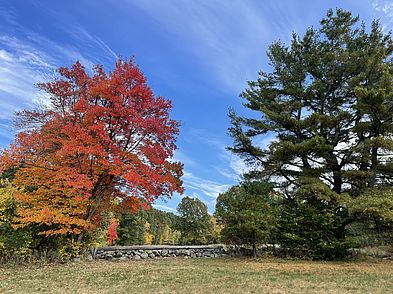John J. Donovan Reservation & Sagamore Hill Conservation Area
Lush Woodlands, Open Meadows & Hilltop Views
This reservation is an expansive natural wonderland, where you can walk, ride, run, and ski over miles of interconnected trails.
Por favor, espere, el mapa se está cargando.
Location, Directions & Parking
- 473 Sagamore Street, Hamilton (Opens in Google Maps)
The land comprising this 270-acre reservation has a long and varied human history, beginning with Native American encampments, and agricultural use that began with early settlement and continues to this day. The open hilltop landscape offers extraordinary views to the mouth of the Essex River, Cape Ann, and the Atlantic Ocean beyond.
Indigenous people known as the Pawtucket or Agawam were living, farming, and fishing here at the time of European contact.
Adjacent to Greenbelt-conserved land is Sagamore Hill, the last home and burial site of Masconomet (Masquenominet), his wife, and unknown others of his band. He was the Pawtucket sagamore of Greater Agawam at the time of English settlement. Please respect these sacred grounds.
A Multi-partner Effort
An extraordinary, multi-partner effort helped Greenbelt successfully complete a $5.1M community-based fundraising campaign to acquire this iconic landscape for conservation. Greenbelt is grateful to the Donovan family who provided the time and opportunity to acquire their land for public benefit. Our sincere thanks goes to our partners and supporters of the project:
- The Trust for Public Land
- Hamilton Wenham Open Land Trust
- Hamilton and Essex Residents via Community Preservation Act Funds
- The Commonwealth of Massachusetts Department of Conservation & Recreation
- Landscape Partnership Program of the Executive Office of Energy & Environmental Affairs
- Over 500 individual donors
In addition to the Donovan Reservation, Greenbelt also secured six adjacent, donated conservation restrictions on privately-owned parcels in Hamilton, Essex and Ipswich that together create a 525-acre corridor of permanently protected land.
The Donovan Reservation has a diverse array of habitats that benefit many plant and animal species. A primary feature are the many fields dispersed across the landscape. Some are active hay fields that are not cut until late summer to allow grassland birds (bobolinks and eastern meadowlarks) and pollinator insects (bees, butterflies, dragon flies) to complete their breeding cycles.
Other fields are mowed annually or even less frequently, creating an open field habitat with some woody vegetation mixed in with milkweed and other annuals that benefits species like monarch butterflies, woodcock and cottontail rabbit. Woodlands and wetlands occur on the remaining land, and are home to mostly hardwood trees and some white pines.
Deer, coyote, red fox, fisher and turkey are abundant. Great-horned and barred owls can be seen and heard with patience and diligence.
Get GreenbeltGo Trails App
Land Acknowledgment
The properties that Greenbelt conserves are on the ancestral lands of the Pennacook and the Pawtucket, bands of Abenaki-speaking people. Join us in honoring the elders who lived here before, the Indigenous descendants today and the generations to come. Learn more…








